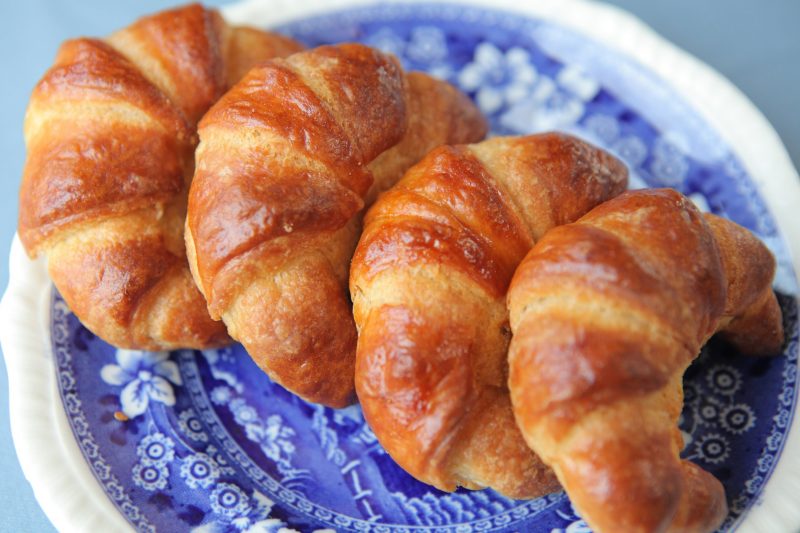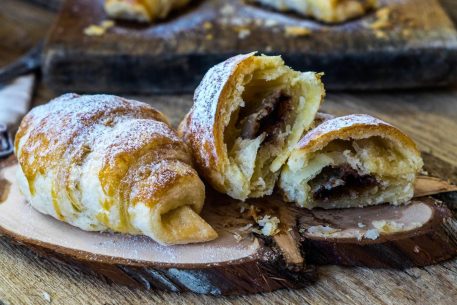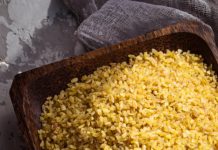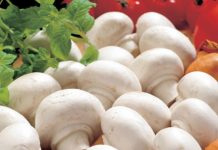Fresh homemade croissants for breakfast are a troublesome story, and few agree to spend an early morning at the stove. As experienced housewives do: the dough for croissants is prepared in advance, the rolled layer is ergonomically cut and blanks are formed in a matter of minutes. Very soon rosy bagels are collected at the table of the most notorious lodgers.
Material Content:
Puff pastry for croissants
Classic croissants are baked from puff pastry. The filling is usually not put in them. The French prefer to enjoy the skill of a baker, so the taste of the dough, the composition and its structure are so important.

Ingredients:
- 300 g flour;
- 100 ml of milk;
- 40 g of sugar;
- 10 g dry yeast;
- 5 g of salt.
It is necessary to distribute the stages of work with the test in advance, carefully calculate the time.
If baking is scheduled for Sunday breakfast, start preparation from Friday.
Friday evening - a mixture of dough and butter.
Work with the test:
- Put all the ingredients in the sifted flour.
- Knead very quickly so that the dough is not delayed.
- Wrap tightly in foil.
- The dough ripens for half an hour indoors and 6 to 8 hours in the refrigerator.
Oil is prepared separately.
- Chopped oil (200 g) with a knife.
- The table is lightly dusted with flour. Oil absorbs it, so use no more than 50 g.
- Knead until soft, not allowing the oil to thaw.
- Roll out into a small rectangle.
- Cool by wrapping in film.
Saturday: preparing the test in four sets with an interval of 2 hours.
- Roll out the dough on parchment.
- Put a plate of oil on it.
- Bend the edges with an overlap.
- With the help of a rolling pin, distribute the oil in an envelope from the dough.
- Roll it several times with a rolling pin in one direction.
- Cover with a second sheet of parchment and put in the cold for 2 hours.
- Four times fold an envelope from the dough, roll and clean in the cold.
- Roll a layer with a thickness of 5 - 6 mm, cover it with cling film and roll it into a roll.
- Put the workpiece in the bag and in the refrigerator.
Sunday: bagel formation, proofing and baking.
- Chop the cold dough.
- Put the stuffing.
- Form blanks.
- Leave for proofing in a warm place for an hour.
- Grease with yolk.
- Bake at 180 ºС for 15 - 20 minutes.
Tasty recipe: puff pastry croissants
Quick recipe
Making yeast dough can be much simpler, although this will not correspond to the canons of French bakers.

Ingredients:
- 200 g of flour;
- 150 g butter;
- 120 g of milk;
- 40 g of sugar;
- 10 g high-speed dry yeast;
- 5 g of salt.
Work Stages:
- Mix flour with yeast, salt and sugar.
- Put frozen butter in it and chop into a crumb with a knife.
- Pour in milk.
- Knead the dough quickly so that the butter does not melt.
- Hold the resulting composition in the cold for half an hour.
- Roll the cold base into the formation. Roll in half, roll out.
- Roll in the other direction and roll again.
- Repeat three times the fold in each direction. If necessary, dust with flour.
- Hold the dough layer in the cold in the film for about 6 hours.
- Roll, chop and roll croissants.
- Bake such a dough for 8 minutes at 220 ºС and another 12 minutes at 180 ºС.
Puff yeast dough for croissants
From puff yeast-free dough, croissants are obtained much faster. Such a basis does not need to be parted for hours.
Ingredients:
- 400 g flour;
- 200 ml of water;
- two eggs;
- 20 ml of strong alcohol;
- 40 ml of vinegar;
- 2 to 3 g of salt.
So that the butter does not melt in the hands, and the dough comes out elastic, the room should be cold - 16 ºС.
In the old days, French bakers made dough in the early morning, while the kitchen was not yet heated. They managed to knead the perfect base without the help of modern mixers and combines.
- Mix the liquid ingredients and pour them into the sifted flour.
- Quickly knead the dough, wrap in a film and put it in the cold.
- Knead 200 g of cold butter with two tablespoons of flour.
- Roll a thick cake out of it, wrap it in a film, and cool with the dough.
- Roll out the workpiece in the same way as puff pastry yeast, but at intervals of cooling for only 30 minutes.
- Cut the finished layer in portions and roll them with traditional crescent-shaped bagels.
- Bake at 220 ºС for 20 minutes.
Curd based
Soft creamy pastry from cottage cheese dough does not need to be stuffed, but you can add it with some sweet jam.

Ingredients:
- 320 g flour;
- 80 g of butter;
- 200 g of fatty cottage cheese;
- 100 g of sugar;
- egg;
- 100 g of sour cream or natural yogurt;
- 10 g of soda;
- vanilla extract.
Working with this test will require several times less time than with puff.
- Thoroughly beat the cottage cheese with a blender or rub through a sieve so that there are no tight lumps.
- Add the rest of the ingredients to it, and sift the flour.
- Half an hour, the dough ripens in the refrigerator under the film.
- Roll out a layer with a thickness of 6 - 7 mm.
- Cut it, roll croissants.
- Bake at 180 ºС, observing the formation of a crust.
How to Wrap Puff Pastry Croissants

- Puff pastry is most often rolled in the shape of a rectangle. The layer is divided into small pieces measuring approximately 25 * 10 centimeters, and each is cut diagonally.
- The dough rolled out in a long strip is divided into high triangles by one zigzag line.
- Curd dough can be rolled out in the form of a circle and then cut it into portioned triangles even easier. The circle is divided into 8 equal wedges with four cuts in diameter. From the obtained high triangles, rolls are twisted, starting from a wide base and ending with an acute angle. A small cut is made at the base of the workpiece so that it is more convenient to roll the roll. The edges of the croissant are slightly pulled together, giving it the shape of a crescent.
The bun got its name due to such a special curved shape. An interesting legend of the era of the Ottoman wars in Europe is connected with this.
During the two-month siege of Vienna, the Turks tried to undermine and penetrate the city wall. The bakers, who rose in the middle of the night to prepare morning bread, warned the city guard of a suspicious noise and frustrated the plans of the Ottoman conquerors. For this occasion, the first crescent-shaped bagel (Wiener Kipferl (German)) was baked. For a long time, their preparation was a purely Viennese tradition.
Only a hundred years later, Marie Antoinette, daughter of the Austrian emperor, brought her favorite recipe to her new homeland. Already here in France, the croissant got its name (croissant (fr.) - crescent) and turned into an airy puff treat.
The most popular fillings for croissants
The filling is laid out on a wide part of the triangle. The product is folded without pinching the edges.
If croissants are baked without filling, a small piece of dough is wrapped in the base of the triangle to give volume to the product.
Traditional morning buns are prepared with both sweet fillings and snack bars.
Dessert croissant begin:
- chocolate
- chocolate fudge with milk, butter and a spoonful of cognac;
- various jams and jams;
- fresh fruits or berries;
- boiled condensed milk;
- marmalade;
- dried fruits and nuts;
- marzipan;
- cottage cheese.
Hearty breakfast lovers prefer:
- ham and hard cheese;
- Chees Feta;
- pieces of game or rabbit meat;
- smoked brisket and other meat delicacies;
- a variety of vegetables, possibly with mushrooms;
- fish and seafood.
A snack filling is sometimes put in a finished croissant, cut in half.
Top bun watered with all kinds of sauces, in accordance with the filling.
In any case, the success of breakfast depends on the quality of puff pastries, its splendor and aroma.


















